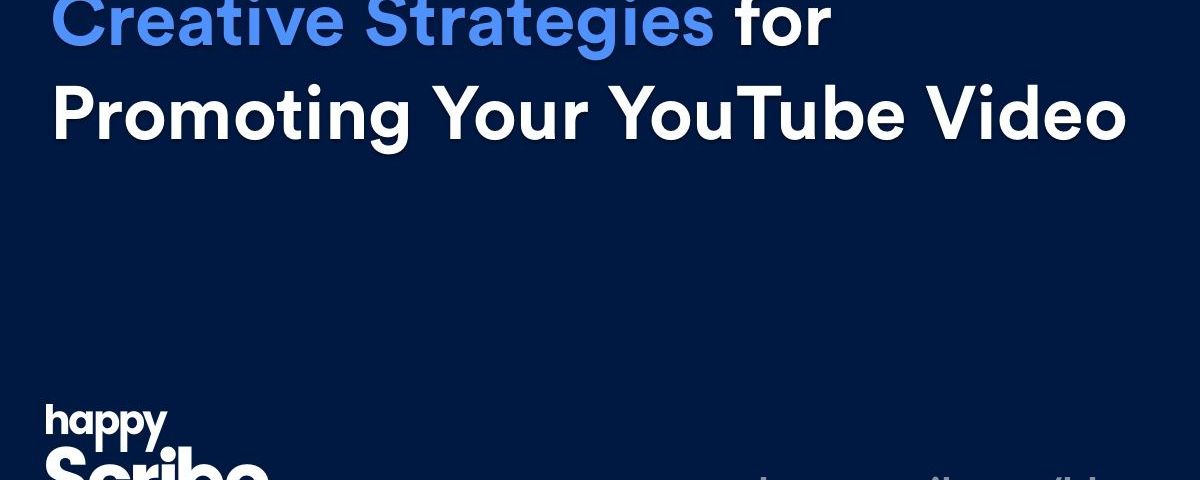There is no doubt about it, video content is King of the Internet. From music videos to cute animal clips to how-to tutorials and beyond, more video content is uploaded to the Internet in 30 days than what the major US televisions networks created in the last 30 years combined. And the main domain for uploading videos remains YouTube with a staggering 300 hours of video uploaded each minute!
This means that relying on Google search engine results to drive traffic organically to your video isn’t going to be enough to boost viewership on your channel. You will also need a strategy for promoting your video.
Below are a seven creative ways to promote your content more broadly that will help get your video out there and give you a chance of earning new subscribers.
Transcribe Your Video and Start a Blog
If you don’t have a website for your YouTube channel yet, get one. Having a YouTube channel and lots of videos is great, but you also need text versions of your content on the Internet.
The main reason for this is that search engines can’t scroll through audio, they need text to be indexed. Having a text based website thus will help your SEO and increase your organic search traffic.
But don’t worry, maintaining a blog for your YouTube channel doesn’t have to be time-consuming. All you need is an automated transcription servicer provider to convert your video-to-text and then upload a full transcription of your video as a blog post. Embed your YouTube video alongside the full transcript and away you go.
If you are already maintaining a blog with unique content then always be sure to ask yourself if there is an already published video on YouTube that you can embed into the post. This will also help drive traffic to your YouTube Channel.
Syndicate Your Video Broadly
The transcription of your video is full of valuable text content which be used beyond a blog post.
Another aspect you should consider in promoting your video is how many different places you can syndicate it beyond YouTube. Some great sites to consider include Twitter, Tumblr, Facebook, LinkedIn and Reddit.
Using the transcription of your video content that you now have, you can search for a key idea that you want to promote on these platforms, and if you use a video-to-text transcription service provider like Happy Scribe, that text will synch up to the exact point in the video. This makes it extremely easy to find a specific part of your video to promote and create a snippet to post on relevant Facebook Groups, LinkedIn Groups, Instagram and other social media sites.
The added benefit here is that you can target the content of your video to a highly relevant audience. Whilst your reach won’t be huge, your audience is more likely to engage with the video your post because it is valuable and informative for them.
Ask for Shares on Social Media
In addition to you sharing your video on social media sites, you can also ask your viewers to take the same action for you.
You can do this by placing a call to action at the end of your video. Whilst you may feel this is a bit forward or rude, it really isn’t as long as you mention it in a sincere way. Something as simple as:
‘If you liked this video, then I’d really appreciate it if you’d like and subscribe to my channel. It would also be great if you consider sharing the video with others who you think might benefit from the content.’
The most prominent YouTubers use this technique to extend their video reach. If you’ve never tried this approach before, give it a go in your next video. You might be surprised by how simply asking your existing subscribers to share, just how much your viewership can increase.
Send Out Email Newsletters to Your Subscribers
Sending out a periodic email newsletter to your scribers is another great way to promote your recent videos.
People are busy and often forget to go check YouTube, but if an email hits their inbox with a update on what you’ve been creating, it can help drive traffic.
Additionally studies show that just using the word ‘video’ in an email subject line increases open rates by 19% and click-through rates by 65%. A simple way to get better engagement.
Once again, you can use the content from your video to text transcript to help you write the newsletter. Maybe pull out a relevant quote or statistic mentioned in your video along with a short description for several videos you have recently released and you have all you need for an engaging newsletter. Include links to the full video and you are sure to increase viewership.
Include a Video Link in Your Email Signature
Email newsletters are great, but another component you should consider is including your latest video in your email signature.
Something as simple as including a video thumbnail with a play button that takes your reader to your video is enough to help you get additional high-retention views. Furthermore, as the people you tend to email are people that generally like you, the viewers are more likely to engage with your content.
Mention Your Video on Quora and Other Q&A Sites
Quora, the question-and-answer website where questions are asked and answered by its community of users, and other forums are a great place to promote your video.
To execute this strategy just sign up to Quora and search for a keyword relevant to your video’s topic. A list of questions should pop up. Scroll through and find a question that you can answer and has a good fit for your video topic. Answer the person’s question as best and you can and include a link to your video at the end of your answer.
The benefit of promoting your video in this type of forum is that you’re posting your video in a place where people are searching for information on a given topic. Therefore the people that watch your video will be more invested and interested viewers, meaning that they are likely to watch more of your video.
Use Playlists
Playlists are arguably one of the best ways to get more views on your YouTube videos. A playlist is just a collection of like videos that you tag under a specific heading. So when someone finds your video located within a playlist, they will also get lots of other videos, created by you, suggested to them to view. Moreover, playlists automatically play every video in the playlist, leading to an significantly higher amount of views per month.
Every video you publish should go into a playlist on your channel page. So either upload it to an existing playlist or create a new one. Just remember that to increase SEO search traffic to your playlist you need to have your keyword in the title of that playlist, and you need to have a detailed description of the playlist that also includes your keyword.
With these creative strategies to promote your YouTube videos, you should get a lot more traffic to your channel and hopefully more YouTube subscribers.
Should you need any help in getting started with transcribing your video to text, then please don’t hesitate to contact us.














